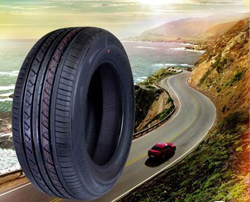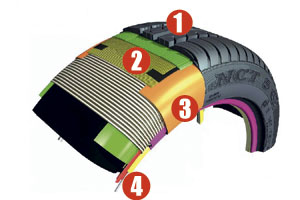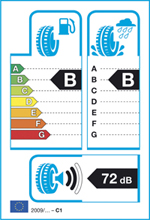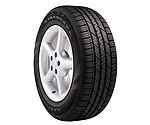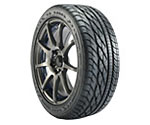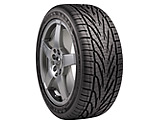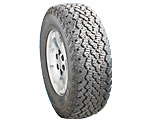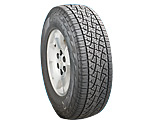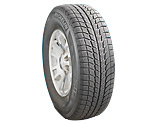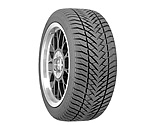A tire (or tyre) is a ring-shaped covering that fits around a wheel's rim to protect it and enable better vehicle performance. Most tires, such as those for automobiles and bicycles, provide traction between the vehicle and the road while providing a flexible cushion that absorbs shock.
The materials of modern pneumatic tires are synthetic rubber, natural rubber, fabric and wire, along with carbon black and other chemical compounds. They consist of a tread and a body. The tread provides traction while the body provides containment for a quantity of compressed air. Before rubber was developed, the first versions of tires were simply bands of metal that fitted around wooden wheels to prevent wear and tear. Early rubber tires were solid (not pneumatic). Today, the majority of tires are pneumatic inflatable structures, comprising a doughnut-shaped body of cords and wires encased in rubber and generally filled with compressed air to form an inflatable cushion. Pneumatic tires are used on many types of vehicles, including cars, bicycles, motorcycles, trucks, earthmovers, and aircraft. Metal tires are still used on locomotives and railcars, and solid rubber (or other polymer) tires are still used in various non-automotive applications, such as some casters, carts, lawnmowers, and wheelbarrows.
| The earliest tires were bands of iron (later steel), placed on wooden wheels, used on carts and wagons. The tire would be heated in a forge fire, placed over the wheel and quenched, causing the metal to contract and fit tightly on the wheel. A skilled worker, known as a wheelwright, carried out this work. The outer ring served to "tie" the wheel segments together for use, providing also a wear-resistant surface to the perimeter of the wheel. The word "tire" thus emerged as a variant spelling to refer to the metal bands used to tie wheels. The first practical pneumatic tire was made by Scottish inventor John Boyd Dunlop while working as a veterinarian in May Street, Belfast in 1887 for his son's bicycle, in an effort to prevent the headaches his son had while riding on rough roads (Dunlop's patent was later declared invalid because of prior art by fellow Scot Robert William Thomson). Dunlop is credited with "realising rubber could withstand the wear and tear of being a tire while retaining its resilience". The development of this technology hinges on myriad engineering advances. In terms of materials, the vulcanization of natural rubber is credited to Charles Goodyear and Robert William Thomson. Synthetic rubbers were invented in the laboratories of Bayer in the 1920s. Today, over 1 billion tires are produced annually in over 400 tire factories, see List of Tire Companies. |
| 1. Tread The tread rubber compound determines how well the tyre grips dry roads. In the wet, the best car tyres disperse water using the grooves of the tread, maintaining rubber contact and therefore grip. 2. Steel belt Rubber-wrapped bundles of steel wire give structural rigidity to the tyre and hold the tread flat to maintain good contact with the road. 3. Sidewalls |
These combine with the air in the tyre to carry the load. Lower, stiffer sidewalls (as found on 'low profile' tyres) help the tyre retain its shape better when cornering. This improves handling but can also make the car's ride less comfortable.
The outside of the sidewall is where you will find the tyre size and specification markings, which you can find out more about in How to read car tyre.
4. Bead-wires
These are ultra-strong steel wires with extreme resistance to stretching, which hold the tyre onto the rim – even at very high speeds and when cornering.
| We've been talking to drivers* about the impending tyre labelling system and nine out of 10 we spoke to weren't aware of it at all. Given that more than eight out of 10 of them have purchased tyres in the last two years (and are presumably likely to buy again in the next), it's important for all consumers to understand what it means. The aim of the labelling system is broadly similar to the aim of all energy labels (as already seen on household goods and even on cars), which is to give consumers an indication of which products are the most economical before they buy. As well as being a handy comparison tool, the label gives manufacturers an incentive to produce tyres with better ratings. This has worked for domestic appliances, where the level of improvement has meant the authorities have had to re-evaluate the rating scales, once all manufacturers are producing towards the top end of the scale. |
| | Car tires - All-season tires Come in sizes to fit everything from small cars to light-duty SUVs and pickups. They are a popular choice for many older vehicles and are for drivers who want year-round traction, long tread wear, and a comfortable ride. But they typically lack the precise handling and grip of performance tires. Speed Ratings: None, S (112 mph), T (118 mph) Tread-wear warranty: None or 40,000 to 100,000 miles Typical wheel size: 14 to 17 inches |
| | Car tires - Performance all-season tires Have a higher speed rating than standard all-season tires. They generally provide better handling and braking, and usually have a lower profile (shorter sidewall height) and a wider footprint. They are a popular choice for many newer cars. Speed Ratings: H (130 mph), V (149 mph) Tread-wear warranty: None or 40,000 to 60,000 miles Typical wheel size: 15 to 17 inches |
| | Car tires - Ultra performance tiress Are commonly fitted to upscale sedans or sporty vehicles. These tires are designed to provide good handling and responsive steering in wet and dry conditions, but the tread wear and ride comfort are common compromises. Summer versions are not intended for cold weather and won't grip in snowy or icy conditions. All-season versions tend to provide a compromise of dry and wet grip relative to summer tires for all weather conditions. Speed Ratings: ZR (more than 149 mph), W (168 mph), Y (186 mph) Tread-wear warranty: None or 30,000 to 40,000 miles Typical wheel size: 17 to 22 inches |
| | Truck tires - All-season truck tires Because of their size, dynamics and how they are used, trucks and SUVs often require special tires. Some automakers advise sticking with the tire type that the vehicle originally came with. Consult the owner's manual to see if a specific type is recommended. Are well rounded and are good for road driving. They are designed to perform reasonably well in most conditions. |
| | Truck tires - All-terrain tires Are suited to paved roads and light-duty off-road use. They provide added traction on unpaved and snowy roads. Speed ratings: S (112 mph) for many. Tread-wear warranty: None or 40,000 to 60,000 miles. Typical wheel size: 15 to 20 inches. |
| | Winter tires have treads with more biting edges for better grip on snow and ice, while their softer compound remains flexible even in extremely low temperatures. But on cleared roads, they might not grip as well as all-season tires and they often wear more quickly. |
| | Performance winter tires provide higher levels of snow and ice grip, but keep some of the handling and cornering capabilities of performance tires. Speed Ratings: Q (99 mph) and higher Tread-wear warranty: None Typical wheel size: 14 to 18 inches |
Top Brands of Tyres
| Based in Tokyo, Bridgestone is one of the three largest tire manufacturers in the world. Bridgestone Americas Tire Operations has its headquarters in Nashville, Tenn. The corporation manufactures and markets Bridgestone, Firestone, Dayton, and Fuzion tires, among other associate brands. It supplies tires for most applications in the United States. Bridgestone and Firestone replacement tires often score well in our tests. |
| Continental is in a distant fourth place in North American and global sales, behind Goodyear, Bridgestone, and Michelin. Still, it offers a full complement of original and replacement tires. The Germany-based Continental Corporation is a top automotive supplier of brake systems and various vehicle components, in addition to tires. The U.S. tire operations have headquarters in Lancaster County, S.C. The company sells the Continental and General tire brands. In the past, General has shined for light-truck tires in our testing. |
| A French company, Michelin has its North America headquarters in Greenville, S.C. As a global tire maker, it offers tires for nearly all applications. In North America, it owns the BFGoodrich and Uniroyal brands. Founded in 1891, Michelin first introduced the radial tire, and the company continues to be a pioneer in tire technologies. Michelin tires generally perform impressively in our all-weather tests and offer many models with low rolling resistance and long tread life. |
| | Pirelli is based in Milan, Italy, and it has a U.S. manufacturing plant in Rome, Ga. Pirelli caters to the high-end market with tires commonly found on luxury and sports cars. It has a stronger presence in Europe than in the United States, and yet Pirelli offers a full line of replacement tire models to fit most cars and light trucks sold in North America. It is an original equipment supplier to the domestic car manufacturers on selected car models. The Pirelli Group business sectors also include real estate, broad-band solutions, and environmental technologies. In our testing, Pirelli tires often impress us with their dry and wet grip and handling. |
| Goodyear claims to be the best-selling tire-maker in North America and is one of the leading tire manufacturers in the world. In 2008, it ranked third behind Michelin and Bridgestone for global tire sales. Based in Akron, Ohio, Goodyear is a major supplier of original and replacement tires and sells tires for most applications. Founded in 1898, Goodyear owns the Dunlop and Kelly-Springfield brands of tires sold in the United States. Goodyear and Dunlop have often been top picks in our Ratings. |
| A Korean corporation, Hankook has its North American headquarters in Wayne, N.J., and a technical center in Akron, Ohio. Hankook is original equipment on several foreign and domestic auto nameplates. It also offers a complete line of replacement tires to fit most domestic cars and light trucks. Generally, Hankook tires we have tested offer good value for their well-rounded, all-weather performance. |
| Founded in Akron, Ohio in 1870 as Goodrich, Tew & Co. by Dr. Benjamin Franklin Goodrich. The company name was changed to the "B.F. Goodrich Company" in 1880, to BFGoodrich in the 1980s. BFGoodrich has been at the heart of the motor car and tyre world for nearly 140 years |
| Dunlop is one of the world's leading manufacturers of high and ultra high performance tyres with an impressive track record of motorsport success. Dunlop's extensive 120 year experience has led to innovative technologies for tyres designed for motorsport, everyday motoring, commercial and agricultural applications. Always looking to maximise driving pleasure, Dunlop offers all types of motorists the performance and durability of the latest tyre technologies. |
Furthger Reading:
Car Tyres - Rating Tyre Performance
Written by Dora Men

